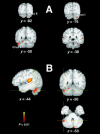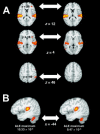Cerebellum and auditory function: an ALE meta-analysis of functional neuroimaging studies
- PMID: 15846816
- PMCID: PMC6871682
- DOI: 10.1002/hbm.20137
Cerebellum and auditory function: an ALE meta-analysis of functional neuroimaging studies
Abstract
Over the past two decades neuroimaging data have accumulated showing that the cerebellum, traditionally viewed only as a motor structure, is also active in a wide variety of sensory and cognitive tasks. We have proposed that instead of explicit involvement in any particular motor, sensory, or cognitive task, the cerebellum performs a much more fundamental computation involving the active acquisition of sensory data. We carried out an activation likelihood estimate (ALE) meta-analysis to determine whether neuroimaging results obtained during a wide range of auditory tasks support this proposal. Specifically, we analyzed the coordinates of 231 activation foci obtained in 15 different auditory studies selected through an extensive search of the positron emission tomography (PET) and functional magnetic resonance imaging (fMRI) literature. The studies selected represent a wide variety of purely auditory tasks using highly controlled synthesized acoustic stimuli. The results clearly revealed that in addition to temporal auditory areas of cerebral cortex, specific regions in the cerebellum are activated consistently across studies regardless of the particular auditory task involved. In particular, one area in left lateral crus I area showed the greatest volume and ALE peak value among the extratemporal regions. A subanalysis was carried out that ruled out the specific association of this cerebellar cluster with attentional demand. The results are consistent with the hypothesis that the cerebellum may play a role in purely sensory auditory processing, and are discussed in light of the broader idea of the cerebellum subserving a fundamental sensory function.
Figures



Similar articles
-
Scaling of neural responses to visual and auditory motion in the human cerebellum.J Neurosci. 2010 Mar 24;30(12):4489-95. doi: 10.1523/JNEUROSCI.5661-09.2010. J Neurosci. 2010. PMID: 20335485 Free PMC article.
-
Characterizing cerebellar activity during autobiographical memory retrieval: ALE and functional connectivity investigations.Neuropsychologia. 2016 Sep;90:80-93. doi: 10.1016/j.neuropsychologia.2016.05.025. Epub 2016 May 25. Neuropsychologia. 2016. PMID: 27235570
-
Recruitment of the motor system during music listening: An ALE meta-analysis of fMRI data.PLoS One. 2018 Nov 19;13(11):e0207213. doi: 10.1371/journal.pone.0207213. eCollection 2018. PLoS One. 2018. PMID: 30452442 Free PMC article.
-
Sensory and cognitive functions.Int Rev Neurobiol. 1997;41:255-71. doi: 10.1016/s0074-7742(08)60355-4. Int Rev Neurobiol. 1997. PMID: 9378591 Review.
-
Stimulus-dependent activations and attention-related modulations in the auditory cortex: a meta-analysis of fMRI studies.Hear Res. 2014 Jan;307:29-41. doi: 10.1016/j.heares.2013.08.001. Epub 2013 Aug 11. Hear Res. 2014. PMID: 23938208 Review.
Cited by
-
Stimulus-responsive and task-dependent activations in occipital regions during pitch perception by early blind listeners.Hum Brain Mapp. 2024 Feb 1;45(2):e26583. doi: 10.1002/hbm.26583. Hum Brain Mapp. 2024. PMID: 38339902 Free PMC article.
-
Disrupted Intraregional Brain Activity and Functional Connectivity in Unilateral Acute Tinnitus Patients With Hearing Loss.Front Neurosci. 2019 Sep 19;13:1010. doi: 10.3389/fnins.2019.01010. eCollection 2019. Front Neurosci. 2019. PMID: 31607851 Free PMC article.
-
Disrupted intra- and inter-network connectivity in unilateral acute tinnitus with hearing loss.Front Aging Neurosci. 2022 Aug 1;14:833437. doi: 10.3389/fnagi.2022.833437. eCollection 2022. Front Aging Neurosci. 2022. PMID: 35978951 Free PMC article.
-
Altered Spatial and Temporal Brain Connectivity in the Salience Network of Sensorineural Hearing Loss and Tinnitus.Front Neurosci. 2019 Mar 19;13:246. doi: 10.3389/fnins.2019.00246. eCollection 2019. Front Neurosci. 2019. PMID: 30941010 Free PMC article.
-
A TMS investigation on the role of the cerebellum in pitch and timbre discrimination.Cerebellum Ataxias. 2016 Mar 2;3:6. doi: 10.1186/s40673-016-0044-4. eCollection 2016. Cerebellum Ataxias. 2016. PMID: 26937285 Free PMC article.
References
-
- Ackermann H, Hertrich I (2000): The contribution of the cerebellum to speech processing. J Neurolinguistics 13: 95–116.
-
- Ackermann H, Riecker A, Mathiak K, Erb M, Grodd W, Wildgruber Dirk (2001): Rate‐dependent activation of a prefrontal‐insular‐cerebellar network during passive listening to trains of click stimuli: an fMRI study. Neuroreport 12: 4087–4092. - PubMed
-
- Aitkin LM, Boyd J (1975): Responses of single units in cerebellar vermis of the cat to monaural and binaural stimuli. J Neurophysiol 38: 418–429. - PubMed
-
- Aitkin LM, Boyd J (1978): Acoustic input to the lateral pontine nuclei. Hear Res 1: 67–77. - PubMed
-
- Akshoomoff NA, Courchesne E (1992): A new role for the cerebellum in cognitive operations. Behav Neurosci 106: 731–738. - PubMed
Publication types
MeSH terms
LinkOut - more resources
Full Text Sources
Other Literature Sources
Medical
Miscellaneous

